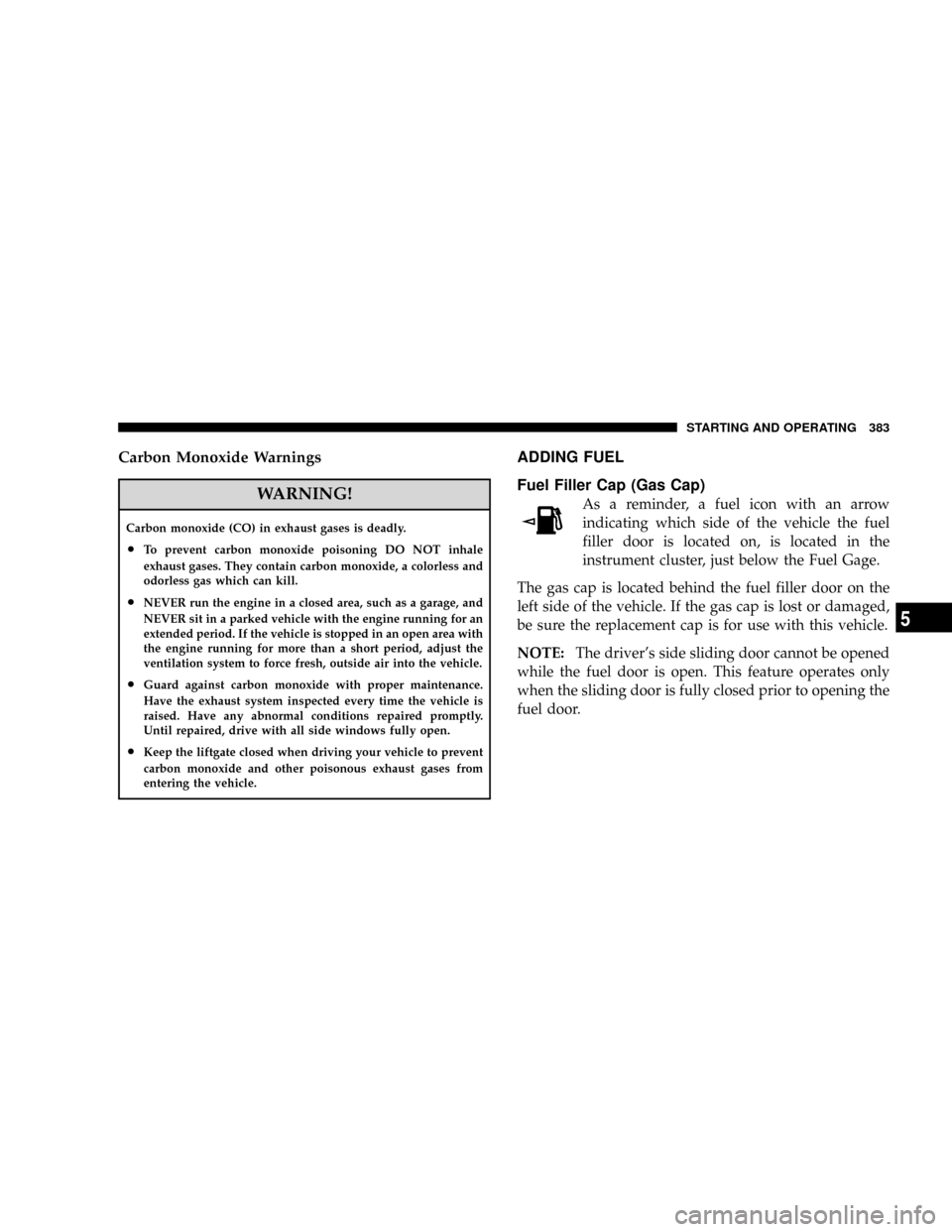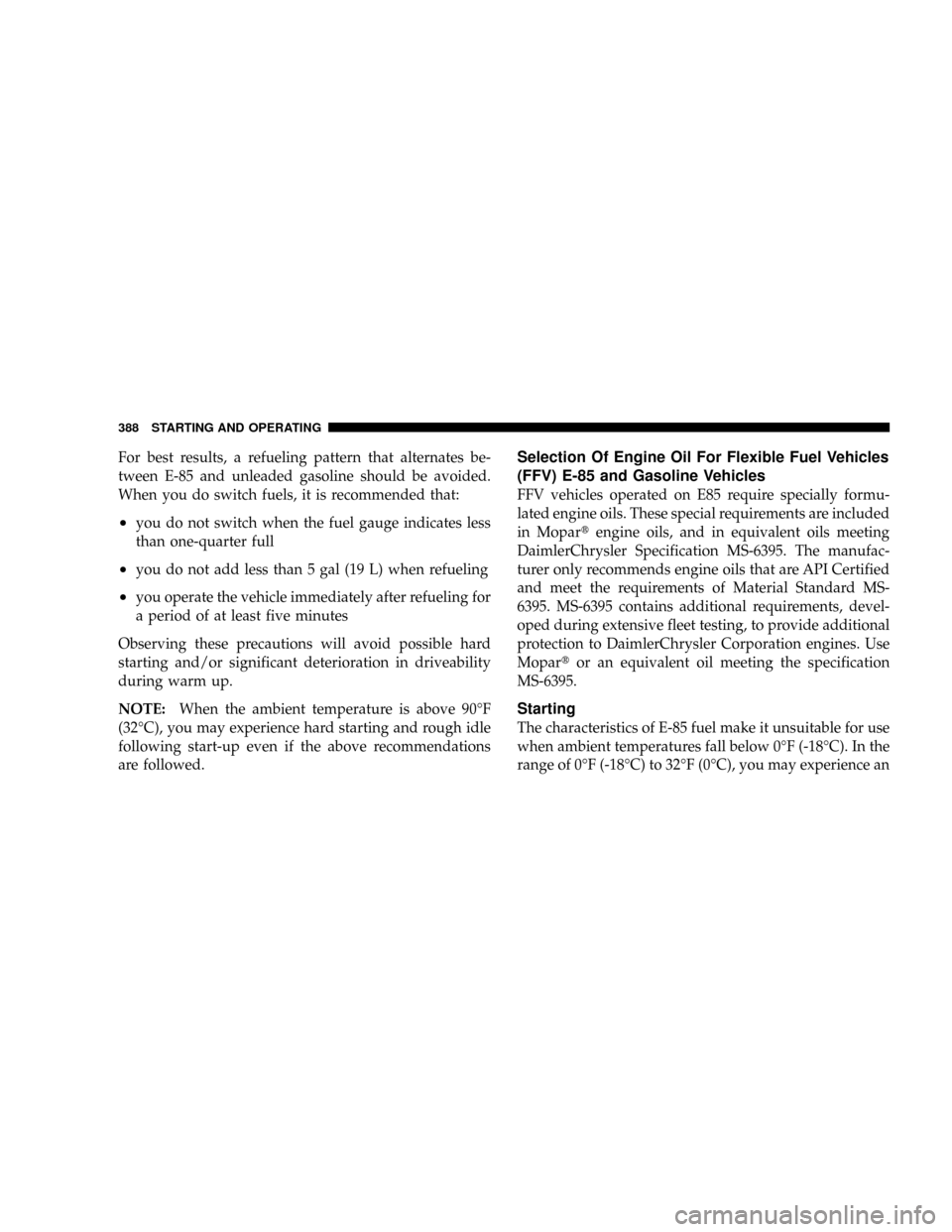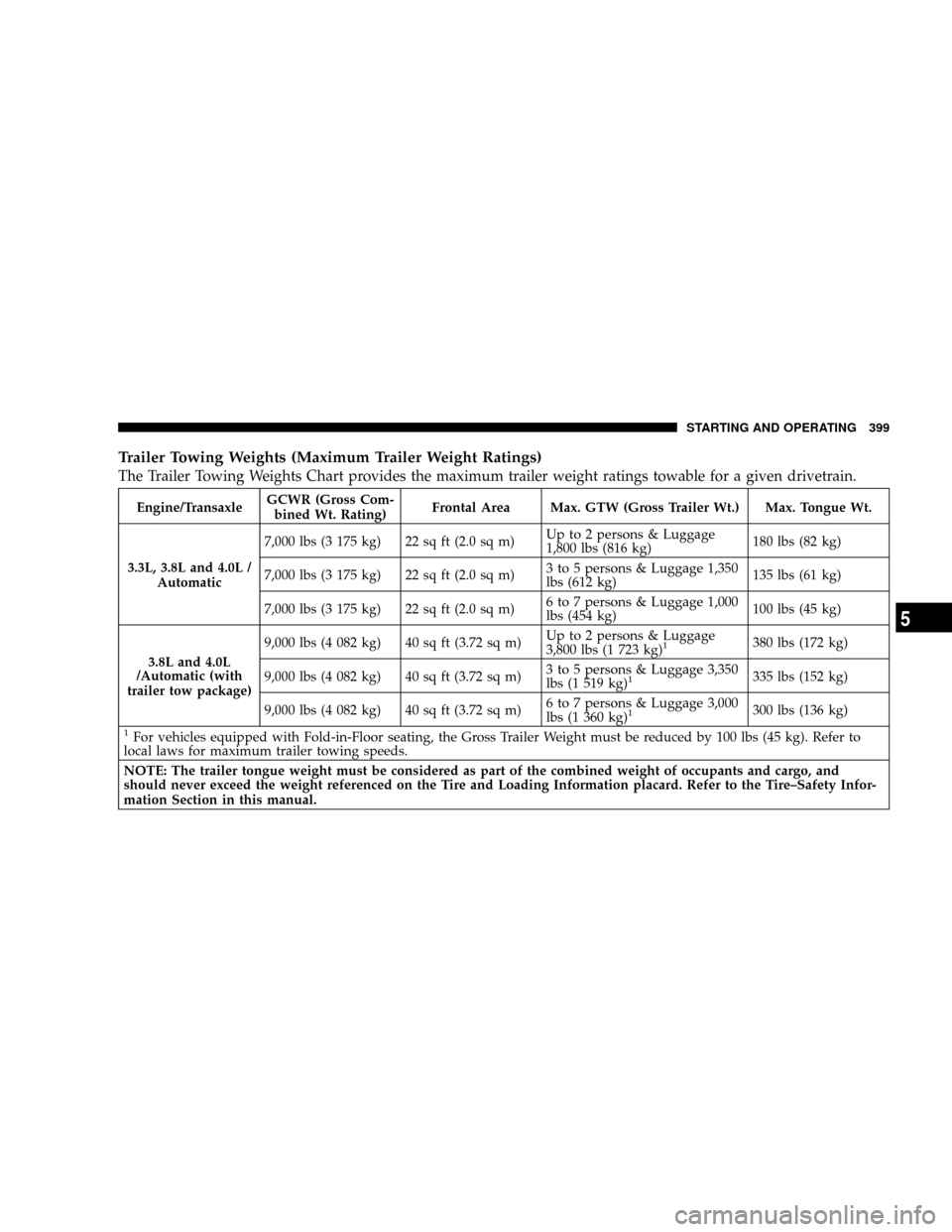Page 385 of 531

Carbon Monoxide Warnings
WARNING!
Carbon monoxide (CO) in exhaust gases is deadly.
²To prevent carbon monoxide poisoning DO NOT inhale
exhaust gases. They contain carbon monoxide, a colorless and
odorless gas which can kill.
²NEVER run the engine in a closed area, such as a garage, and
NEVER sit in a parked vehicle with the engine running for an
extended period. If the vehicle is stopped in an open area with
the engine running for more than a short period, adjust the
ventilation system to force fresh, outside air into the vehicle.
²Guard against carbon monoxide with proper maintenance.
Have the exhaust system inspected every time the vehicle is
raised. Have any abnormal conditions repaired promptly.
Until repaired, drive with all side windows fully open.
²Keep the liftgate closed when driving your vehicle to prevent
carbon monoxide and other poisonous exhaust gases from
entering the vehicle.
ADDING FUEL
Fuel Filler Cap (Gas Cap)
As a reminder, a fuel icon with an arrow
indicating which side of the vehicle the fuel
filler door is located on, is located in the
instrument cluster, just below the Fuel Gage.
The gas cap is located behind the fuel filler door on the
left side of the vehicle. If the gas cap is lost or damaged,
be sure the replacement cap is for use with this vehicle.
NOTE:The driver's side sliding door cannot be opened
while the fuel door is open. This feature operates only
when the sliding door is fully closed prior to opening the
fuel door.
STARTING AND OPERATING 383
5
Page 386 of 531
CAUTION!
Damage to the fuel system or emission control sys-
tem could result from using an improper fuel tank
filler tube cap (gas cap). A poorly fitting cap could let
impurities into the fuel system and may cause the
Malfunction Indicator Light (MIL) to turn on due to
fuel vapors escaping from the system.
CAUTION!
To avoid fuel spillage and overfilling, do not ªtop
offº the fuel tank after filling.NOTE:When the fuel nozzle ªclicksº or shuts off, the
fuel tank is full.
WARNING!
²Never have any smoking materials lit in or near
the vehicle when the gas cap is removed or the
tank filled.
²Never add fuel when the engine is running. This is
in violation of most state and federal fire regula-
tions and will cause the malfunction indicator
light to turn on.
384 STARTING AND OPERATING
Page 388 of 531
FLEXIBLE FUEL Ð 3.3L ENGINES ONLY
E-85 General Information
The information in this section is for Flexible Fuel Ve-
hicles (FFV) only. These vehicles can be identified by the
unique fuel filler door label that states:Ethanol (E-85) or
Unleaded Gasoline Only.This section only covers those
subjects that are unique to these vehicles. Please refer to
the other sections of this manual for information on
features that are common between Flexible Fuel and
gasoline only powered vehicles.
E-85 Fuel Cap
386 STARTING AND OPERATING
Page 390 of 531

For best results, a refueling pattern that alternates be-
tween E-85 and unleaded gasoline should be avoided.
When you do switch fuels, it is recommended that:
²you do not switch when the fuel gauge indicates less
than one-quarter full
²you do not add less than 5 gal (19 L) when refueling
²you operate the vehicle immediately after refueling for
a period of at least five minutes
Observing these precautions will avoid possible hard
starting and/or significant deterioration in driveability
during warm up.
NOTE:When the ambient temperature is above 90ÉF
(32ÉC), you may experience hard starting and rough idle
following start-up even if the above recommendations
are followed.
Selection Of Engine Oil For Flexible Fuel Vehicles
(FFV) E-85 and Gasoline Vehicles
FFV vehicles operated on E85 require specially formu-
lated engine oils. These special requirements are included
in Mopartengine oils, and in equivalent oils meeting
DaimlerChrysler Specification MS-6395. The manufac-
turer only recommends engine oils that are API Certified
and meet the requirements of Material Standard MS-
6395. MS-6395 contains additional requirements, devel-
oped during extensive fleet testing, to provide additional
protection to DaimlerChrysler Corporation engines. Use
Mopartor an equivalent oil meeting the specification
MS-6395.
Starting
The characteristics of E-85 fuel make it unsuitable for use
when ambient temperatures fall below 0ÉF (-18ÉC). In the
range of 0ÉF (-18ÉC) to 32ÉF (0ÉC), you may experience an
388 STARTING AND OPERATING
Page 391 of 531
increase in the time it takes for your engine to start, and
a deterioration in driveability (sags and/or hesitations)
until the engine is fully warmed up.
Cruising Range
Because E-85 fuel contains less energy per gallon than
gasoline, you will experience an increase in fuel con-
sumption. You can expect your MPG and your driving
range to decrease by about 30% compared to gasoline
operation.
Replacement Parts
Many components in your Flexible Fuel Vehicle (FFV) are
designed to be compatible with ethanol. Always be sure
that your vehicle is serviced with correct ethanol com-
patible parts.
CAUTION!
Replacing fuel system components with non-ethanol
compatible components can damage your vehicle.
Maintenance
If you operate the vehicle using E-85 fuel, follow the
maintenance schedule section of this manual.
CAUTION!
Do not use ethanol mixture greater than 85% in your
vehicle. It will cause difficulty in cold starting and
may affect driveability.
STARTING AND OPERATING 389
5
Page 401 of 531

Trailer Towing Weights (Maximum Trailer Weight Ratings)
The Trailer Towing Weights Chart provides the maximum trailer weight ratings towable for a given drivetrain.
Engine/TransaxleGCWR (Gross Com-
bined Wt. Rating)Frontal Area Max. GTW (Gross Trailer Wt.) Max. Tongue Wt.
3.3L, 3.8L and 4.0L /
Automatic7,000 lbs (3 175 kg) 22 sq ft (2.0 sq m)Up to 2 persons & Luggage
1,800 lbs (816 kg)180 lbs (82 kg)
7,000 lbs (3 175 kg) 22 sq ft (2.0 sq m)3 to 5 persons & Luggage 1,350
lbs (612 kg)135 lbs (61 kg)
7,000 lbs (3 175 kg) 22 sq ft (2.0 sq m)6 to 7 persons & Luggage 1,000
lbs (454 kg)100 lbs (45 kg)
3.8L and 4.0L
/Automatic (with
trailer tow package)9,000 lbs (4 082 kg) 40 sq ft (3.72 sq m)Up to 2 persons & Luggage
3,800 lbs (1 723 kg)
1380 lbs (172 kg)
9,000 lbs (4 082 kg) 40 sq ft (3.72 sq m)3 to 5 persons & Luggage 3,350
lbs (1 519 kg)
1335 lbs (152 kg)
9,000 lbs (4 082 kg) 40 sq ft (3.72 sq m)6 to 7 persons & Luggage 3,000
lbs (1 360 kg)
1300 lbs (136 kg)
1For vehicles equipped with Fold-in-Floor seating, the Gross Trailer Weight must be reduced by 100 lbs (45 kg). Refer to
local laws for maximum trailer towing speeds.
NOTE: The trailer tongue weight must be considered as part of the combined weight of occupants and cargo, and
should never exceed the weight referenced on the Tire and Loading Information placard. Refer to the Tire±Safety Infor-
mation Section in this manual.
STARTING AND OPERATING 399
5
Page 404 of 531

WARNING!
Improper towing can lead to an injury accident.
Follow these guidelines to make your trailer towing
as safe as possible:
Make certain that the load is secured in the trailer
and will not shift during travel. When trailering
cargo that is not fully secured, dynamic load shifts
can occur that may be difficult for the driver to
control. You could lose control of your vehicle and
have an accident.
²When hauling cargo or towing a trailer, do not over-
load your vehicle or trailer. Overloading can cause a
loss of control, poor performance or damage to brakes,
axle, engine, transmission, steering, suspension, chas-
sis structure or tires.
²Safety chains must always be used between your
vehicle and trailer. Always connect the chains to the
frame or hook retainers of the vehicle hitch. Cross the
chains under the trailer tongue and allow enough
slack for turning corners.
²Vehicles with trailers should not be parked on a grade.
When parking, apply the parking brake on the tow
vehicle. Put the tow vehicle automatic transmission in
PARK. Always, block or9chock9the trailer wheels.
²GCWR must not be exceeded.
²Total weight must be distributed between the tow
vehicle and the trailer such that the following four
ratings are not exceeded:
1. GVWR
2. GTW
3. GAWR
402 STARTING AND OPERATING
Page 408 of 531

Towing Tips Ð Automatic Transmission
The DRIVE gear can be selected when towing. However,
if frequent shifting occurs while in DRIVE, move the gear
selector lever into third gear (with four-speed transmis-
sion) or fifth gear (with six-speed transmission).
NOTE:Moving the gear selector lever into third gear
(with four-speed transmission) or fifth gear (with six-
speed transmission) while operating the vehicle under
heavy operating conditions will improve performance
and extend transmission life by reducing excessive shift-
ing and heat build up. This action will also provide better
engine braking.
The automatic transmission fluid and filter should be
changed if you REGULARLY tow a trailer for more than
45 minutes of continuous operation. Refer to the ªMain-
tenance Scheduleº in Section 8 of this manual for trans-
mission fluid change intervals.NOTE:²Check the automatic transmission fluid level before
towing.
²The six-speed automatic transmission is sealed and
requires an authorized dealer service center to check
the transmission fluid.
Towing Tips Ð Electronic Speed Control (If
Equipped)
²
Don't use in hilly terrain or with heavy loads.
²When using the speed control, if you experience speed
drops greater than 10 mph (16 km/h), disengage until
you can get back to cruising speed.
²Use speed control in flat terrain and with light loads to
maximize fuel efficiency.
406 STARTING AND OPERATING